Bachelor Nursing Assignment
VerifiedAdded on 2022/12/27
|11
|2848
|1
AI Summary
This assignment discusses the assessment and discussion about healthy ageing for an older person with advanced dementia. It includes the interview, assessment findings, implications, and interventions.
Contribute Materials
Your contribution can guide someone’s learning journey. Share your
documents today.
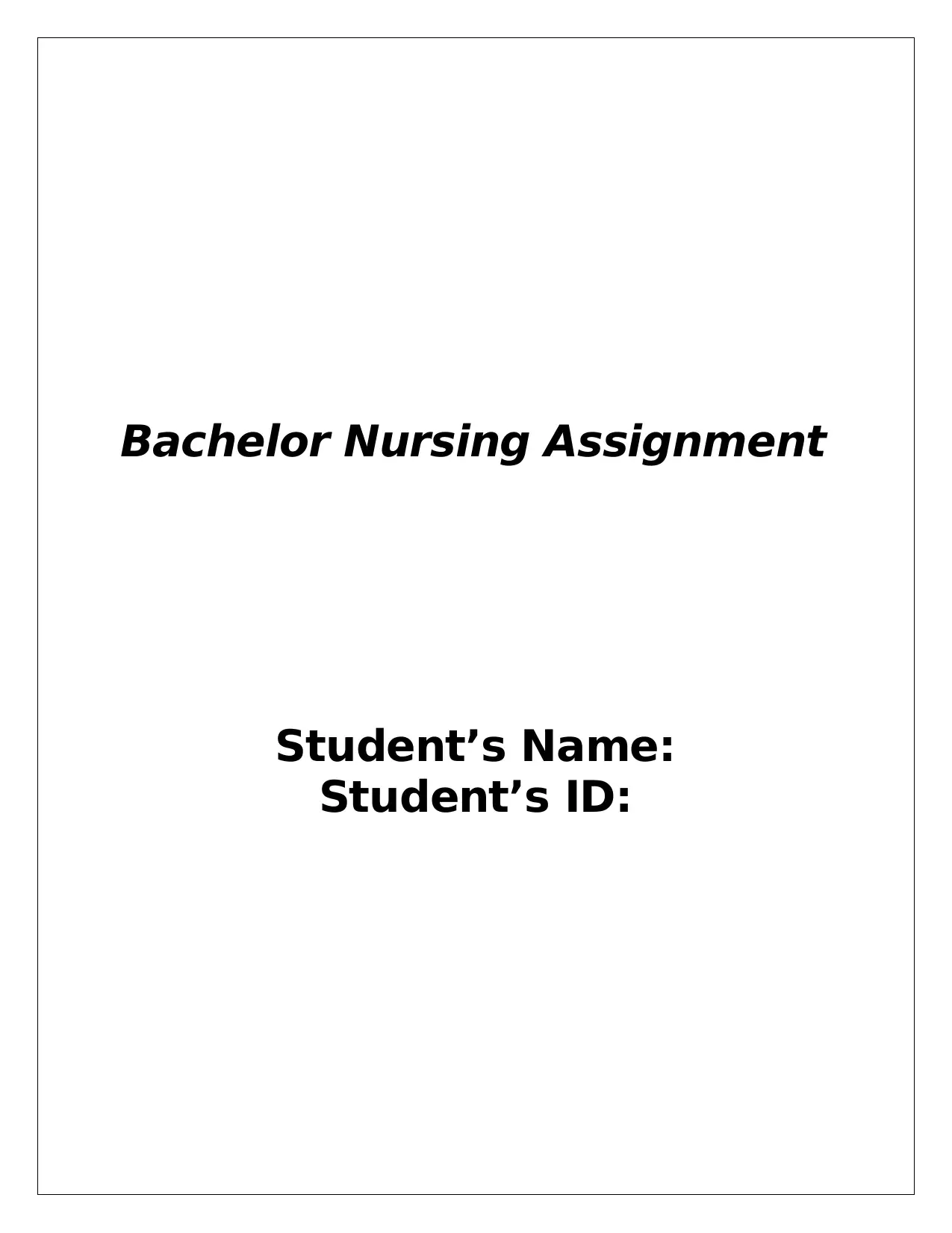
Bachelor Nursing Assignment
Student’s Name:
Student’s ID:
Student’s Name:
Student’s ID:
Secure Best Marks with AI Grader
Need help grading? Try our AI Grader for instant feedback on your assignments.
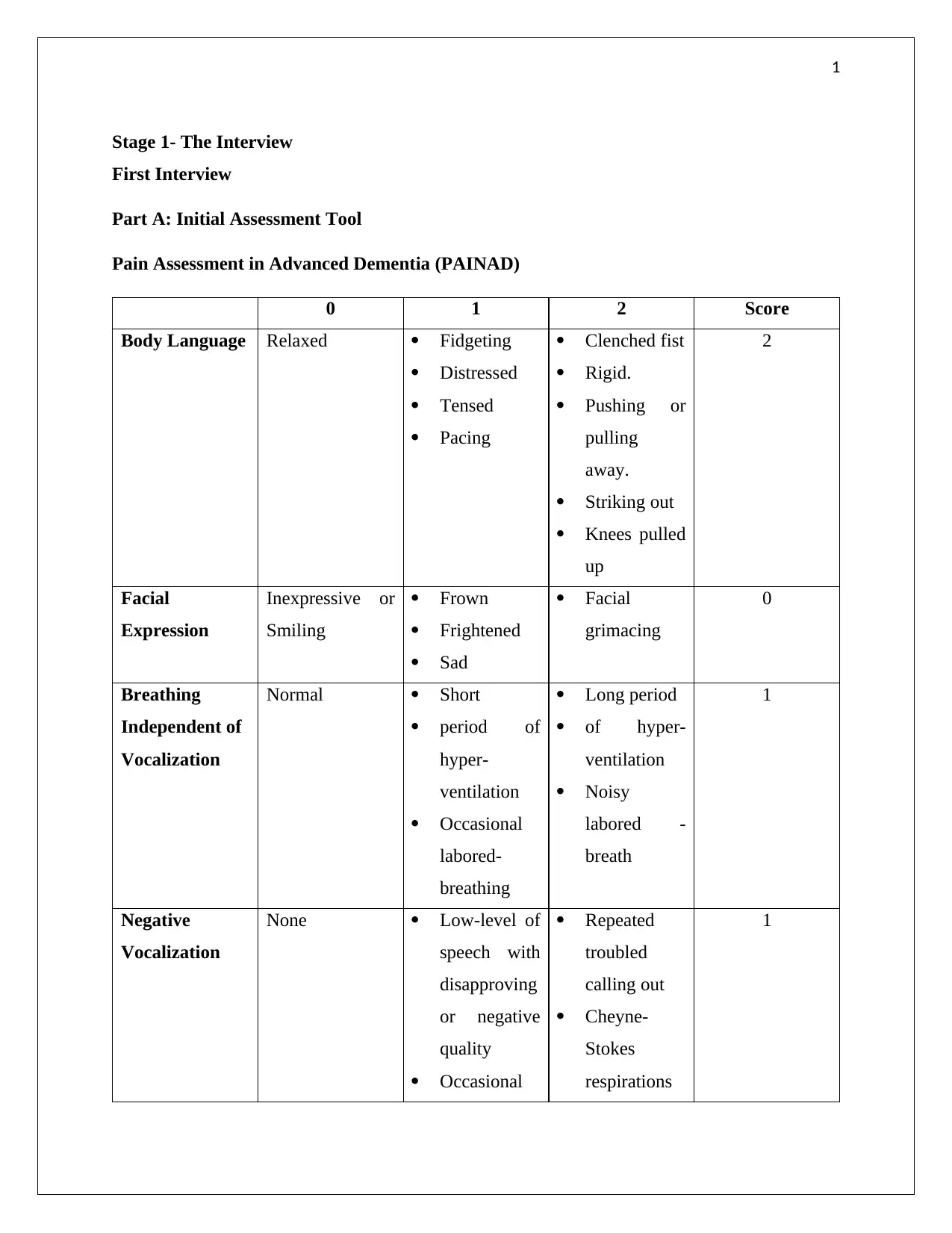
1
Stage 1- The Interview
First Interview
Part A: Initial Assessment Tool
Pain Assessment in Advanced Dementia (PAINAD)
0 1 2 Score
Body Language Relaxed Fidgeting
Distressed
Tensed
Pacing
Clenched fist
Rigid.
Pushing or
pulling
away.
Striking out
Knees pulled
up
2
Facial
Expression
Inexpressive or
Smiling
Frown
Frightened
Sad
Facial
grimacing
0
Breathing
Independent of
Vocalization
Normal Short
period of
hyper-
ventilation
Occasional
labored-
breathing
Long period
of hyper-
ventilation
Noisy
labored -
breath
1
Negative
Vocalization
None Low-level of
speech with
disapproving
or negative
quality
Occasional
Repeated
troubled
calling out
Cheyne-
Stokes
respirations
1
Stage 1- The Interview
First Interview
Part A: Initial Assessment Tool
Pain Assessment in Advanced Dementia (PAINAD)
0 1 2 Score
Body Language Relaxed Fidgeting
Distressed
Tensed
Pacing
Clenched fist
Rigid.
Pushing or
pulling
away.
Striking out
Knees pulled
up
2
Facial
Expression
Inexpressive or
Smiling
Frown
Frightened
Sad
Facial
grimacing
0
Breathing
Independent of
Vocalization
Normal Short
period of
hyper-
ventilation
Occasional
labored-
breathing
Long period
of hyper-
ventilation
Noisy
labored -
breath
1
Negative
Vocalization
None Low-level of
speech with
disapproving
or negative
quality
Occasional
Repeated
troubled
calling out
Cheyne-
Stokes
respirations
1
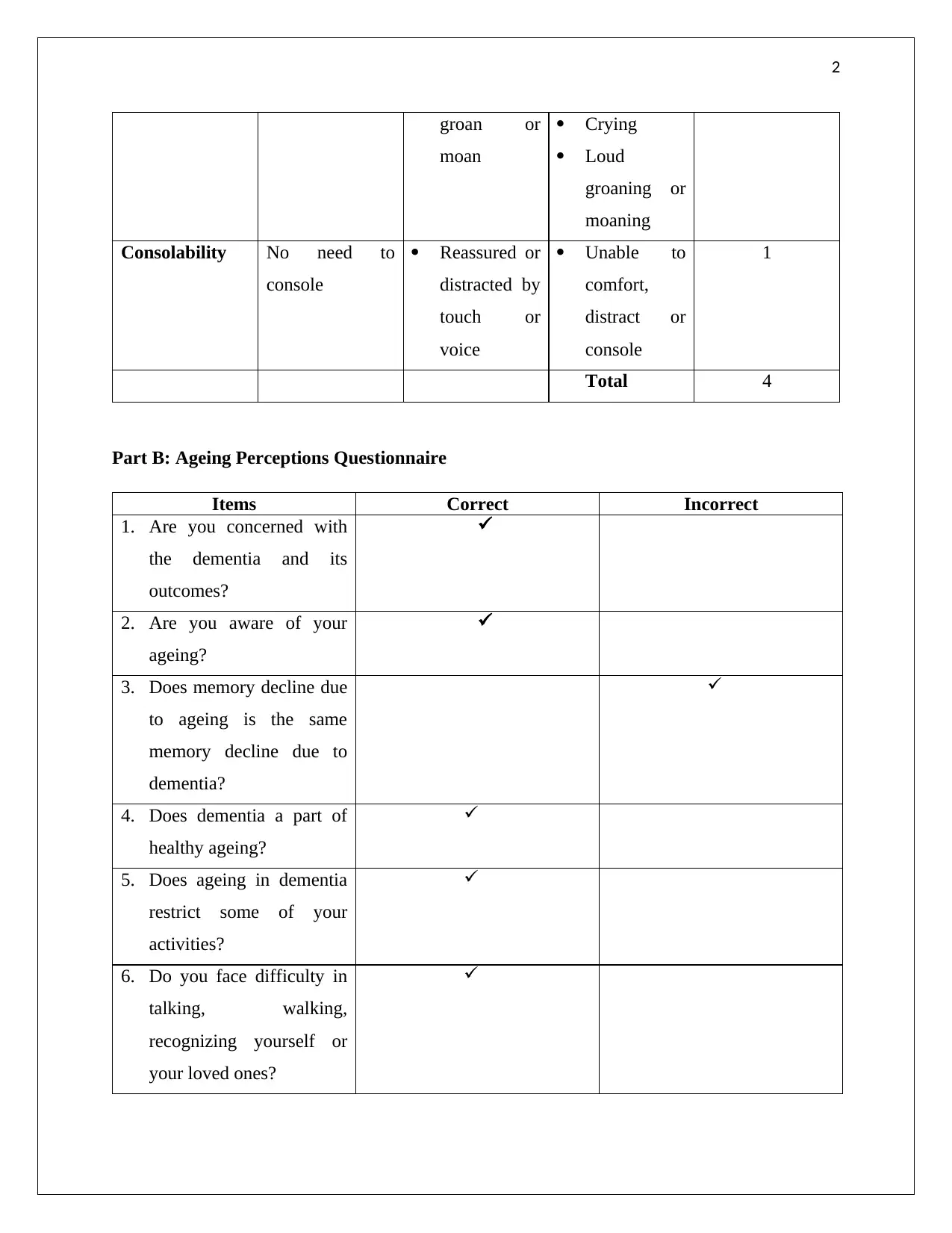
2
groan or
moan
Crying
Loud
groaning or
moaning
Consolability No need to
console
Reassured or
distracted by
touch or
voice
Unable to
comfort,
distract or
console
1
Total 4
Part B: Ageing Perceptions Questionnaire
Items Correct Incorrect
1. Are you concerned with
the dementia and its
outcomes?
2. Are you aware of your
ageing?
3. Does memory decline due
to ageing is the same
memory decline due to
dementia?
4. Does dementia a part of
healthy ageing?
5. Does ageing in dementia
restrict some of your
activities?
6. Do you face difficulty in
talking, walking,
recognizing yourself or
your loved ones?
groan or
moan
Crying
Loud
groaning or
moaning
Consolability No need to
console
Reassured or
distracted by
touch or
voice
Unable to
comfort,
distract or
console
1
Total 4
Part B: Ageing Perceptions Questionnaire
Items Correct Incorrect
1. Are you concerned with
the dementia and its
outcomes?
2. Are you aware of your
ageing?
3. Does memory decline due
to ageing is the same
memory decline due to
dementia?
4. Does dementia a part of
healthy ageing?
5. Does ageing in dementia
restrict some of your
activities?
6. Do you face difficulty in
talking, walking,
recognizing yourself or
your loved ones?
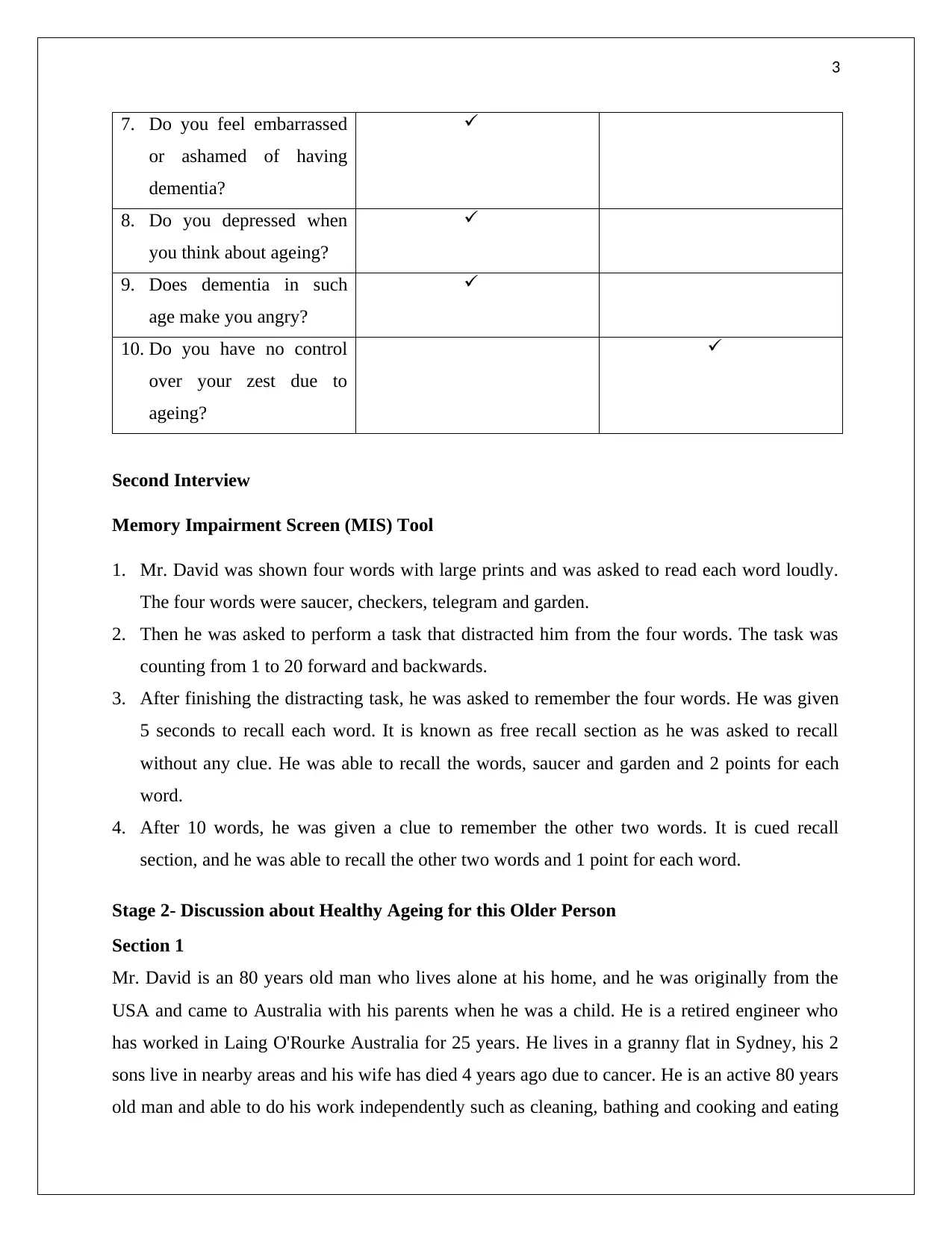
3
7. Do you feel embarrassed
or ashamed of having
dementia?
8. Do you depressed when
you think about ageing?
9. Does dementia in such
age make you angry?
10. Do you have no control
over your zest due to
ageing?
Second Interview
Memory Impairment Screen (MIS) Tool
1. Mr. David was shown four words with large prints and was asked to read each word loudly.
The four words were saucer, checkers, telegram and garden.
2. Then he was asked to perform a task that distracted him from the four words. The task was
counting from 1 to 20 forward and backwards.
3. After finishing the distracting task, he was asked to remember the four words. He was given
5 seconds to recall each word. It is known as free recall section as he was asked to recall
without any clue. He was able to recall the words, saucer and garden and 2 points for each
word.
4. After 10 words, he was given a clue to remember the other two words. It is cued recall
section, and he was able to recall the other two words and 1 point for each word.
Stage 2- Discussion about Healthy Ageing for this Older Person
Section 1
Mr. David is an 80 years old man who lives alone at his home, and he was originally from the
USA and came to Australia with his parents when he was a child. He is a retired engineer who
has worked in Laing O'Rourke Australia for 25 years. He lives in a granny flat in Sydney, his 2
sons live in nearby areas and his wife has died 4 years ago due to cancer. He is an active 80 years
old man and able to do his work independently such as cleaning, bathing and cooking and eating
7. Do you feel embarrassed
or ashamed of having
dementia?
8. Do you depressed when
you think about ageing?
9. Does dementia in such
age make you angry?
10. Do you have no control
over your zest due to
ageing?
Second Interview
Memory Impairment Screen (MIS) Tool
1. Mr. David was shown four words with large prints and was asked to read each word loudly.
The four words were saucer, checkers, telegram and garden.
2. Then he was asked to perform a task that distracted him from the four words. The task was
counting from 1 to 20 forward and backwards.
3. After finishing the distracting task, he was asked to remember the four words. He was given
5 seconds to recall each word. It is known as free recall section as he was asked to recall
without any clue. He was able to recall the words, saucer and garden and 2 points for each
word.
4. After 10 words, he was given a clue to remember the other two words. It is cued recall
section, and he was able to recall the other two words and 1 point for each word.
Stage 2- Discussion about Healthy Ageing for this Older Person
Section 1
Mr. David is an 80 years old man who lives alone at his home, and he was originally from the
USA and came to Australia with his parents when he was a child. He is a retired engineer who
has worked in Laing O'Rourke Australia for 25 years. He lives in a granny flat in Sydney, his 2
sons live in nearby areas and his wife has died 4 years ago due to cancer. He is an active 80 years
old man and able to do his work independently such as cleaning, bathing and cooking and eating
Secure Best Marks with AI Grader
Need help grading? Try our AI Grader for instant feedback on your assignments.
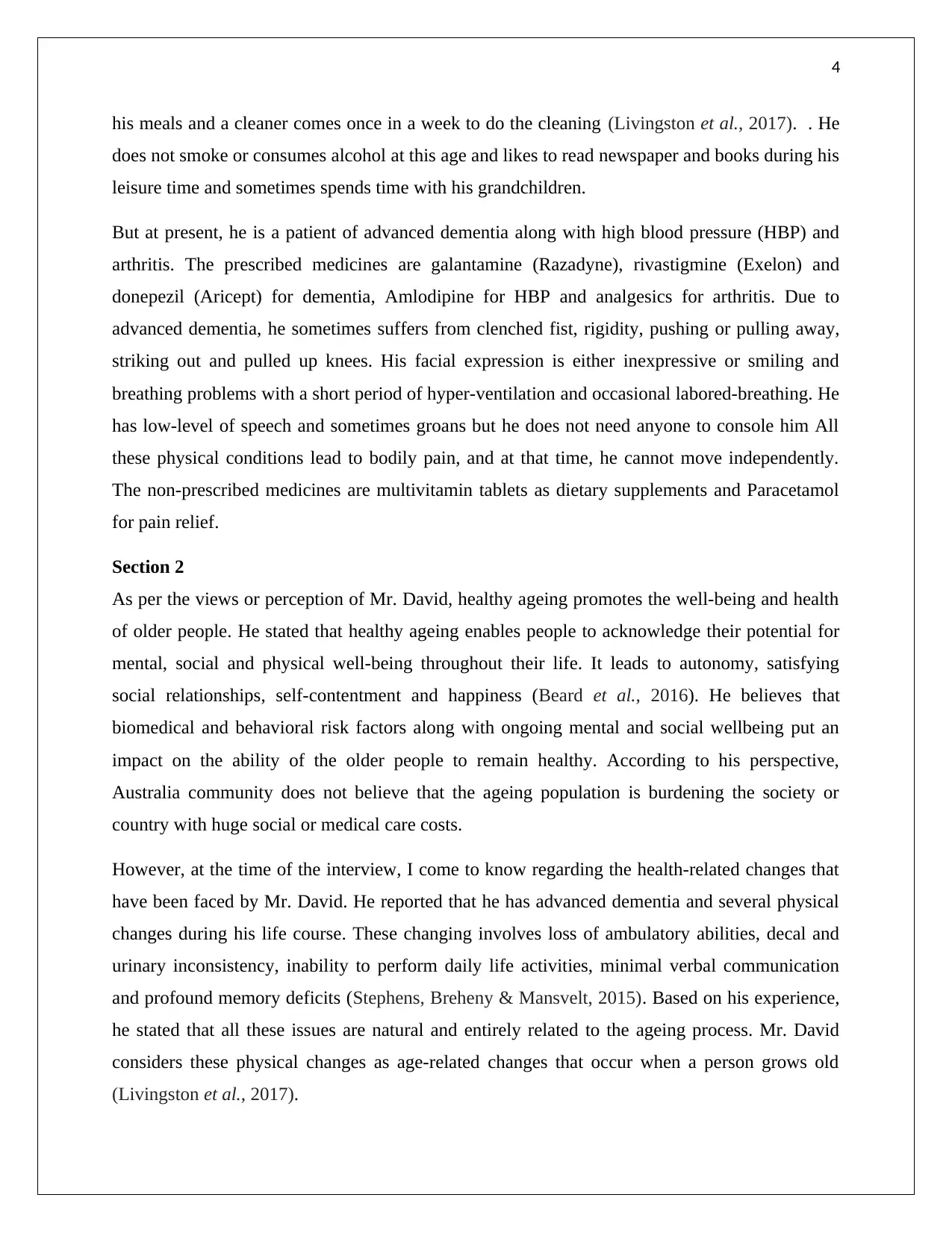
4
his meals and a cleaner comes once in a week to do the cleaning (Livingston et al., 2017). . He
does not smoke or consumes alcohol at this age and likes to read newspaper and books during his
leisure time and sometimes spends time with his grandchildren.
But at present, he is a patient of advanced dementia along with high blood pressure (HBP) and
arthritis. The prescribed medicines are galantamine (Razadyne), rivastigmine (Exelon) and
donepezil (Aricept) for dementia, Amlodipine for HBP and analgesics for arthritis. Due to
advanced dementia, he sometimes suffers from clenched fist, rigidity, pushing or pulling away,
striking out and pulled up knees. His facial expression is either inexpressive or smiling and
breathing problems with a short period of hyper-ventilation and occasional labored-breathing. He
has low-level of speech and sometimes groans but he does not need anyone to console him All
these physical conditions lead to bodily pain, and at that time, he cannot move independently.
The non-prescribed medicines are multivitamin tablets as dietary supplements and Paracetamol
for pain relief.
Section 2
As per the views or perception of Mr. David, healthy ageing promotes the well-being and health
of older people. He stated that healthy ageing enables people to acknowledge their potential for
mental, social and physical well-being throughout their life. It leads to autonomy, satisfying
social relationships, self-contentment and happiness (Beard et al., 2016). He believes that
biomedical and behavioral risk factors along with ongoing mental and social wellbeing put an
impact on the ability of the older people to remain healthy. According to his perspective,
Australia community does not believe that the ageing population is burdening the society or
country with huge social or medical care costs.
However, at the time of the interview, I come to know regarding the health-related changes that
have been faced by Mr. David. He reported that he has advanced dementia and several physical
changes during his life course. These changing involves loss of ambulatory abilities, decal and
urinary inconsistency, inability to perform daily life activities, minimal verbal communication
and profound memory deficits (Stephens, Breheny & Mansvelt, 2015). Based on his experience,
he stated that all these issues are natural and entirely related to the ageing process. Mr. David
considers these physical changes as age-related changes that occur when a person grows old
(Livingston et al., 2017).
his meals and a cleaner comes once in a week to do the cleaning (Livingston et al., 2017). . He
does not smoke or consumes alcohol at this age and likes to read newspaper and books during his
leisure time and sometimes spends time with his grandchildren.
But at present, he is a patient of advanced dementia along with high blood pressure (HBP) and
arthritis. The prescribed medicines are galantamine (Razadyne), rivastigmine (Exelon) and
donepezil (Aricept) for dementia, Amlodipine for HBP and analgesics for arthritis. Due to
advanced dementia, he sometimes suffers from clenched fist, rigidity, pushing or pulling away,
striking out and pulled up knees. His facial expression is either inexpressive or smiling and
breathing problems with a short period of hyper-ventilation and occasional labored-breathing. He
has low-level of speech and sometimes groans but he does not need anyone to console him All
these physical conditions lead to bodily pain, and at that time, he cannot move independently.
The non-prescribed medicines are multivitamin tablets as dietary supplements and Paracetamol
for pain relief.
Section 2
As per the views or perception of Mr. David, healthy ageing promotes the well-being and health
of older people. He stated that healthy ageing enables people to acknowledge their potential for
mental, social and physical well-being throughout their life. It leads to autonomy, satisfying
social relationships, self-contentment and happiness (Beard et al., 2016). He believes that
biomedical and behavioral risk factors along with ongoing mental and social wellbeing put an
impact on the ability of the older people to remain healthy. According to his perspective,
Australia community does not believe that the ageing population is burdening the society or
country with huge social or medical care costs.
However, at the time of the interview, I come to know regarding the health-related changes that
have been faced by Mr. David. He reported that he has advanced dementia and several physical
changes during his life course. These changing involves loss of ambulatory abilities, decal and
urinary inconsistency, inability to perform daily life activities, minimal verbal communication
and profound memory deficits (Stephens, Breheny & Mansvelt, 2015). Based on his experience,
he stated that all these issues are natural and entirely related to the ageing process. Mr. David
considers these physical changes as age-related changes that occur when a person grows old
(Livingston et al., 2017).
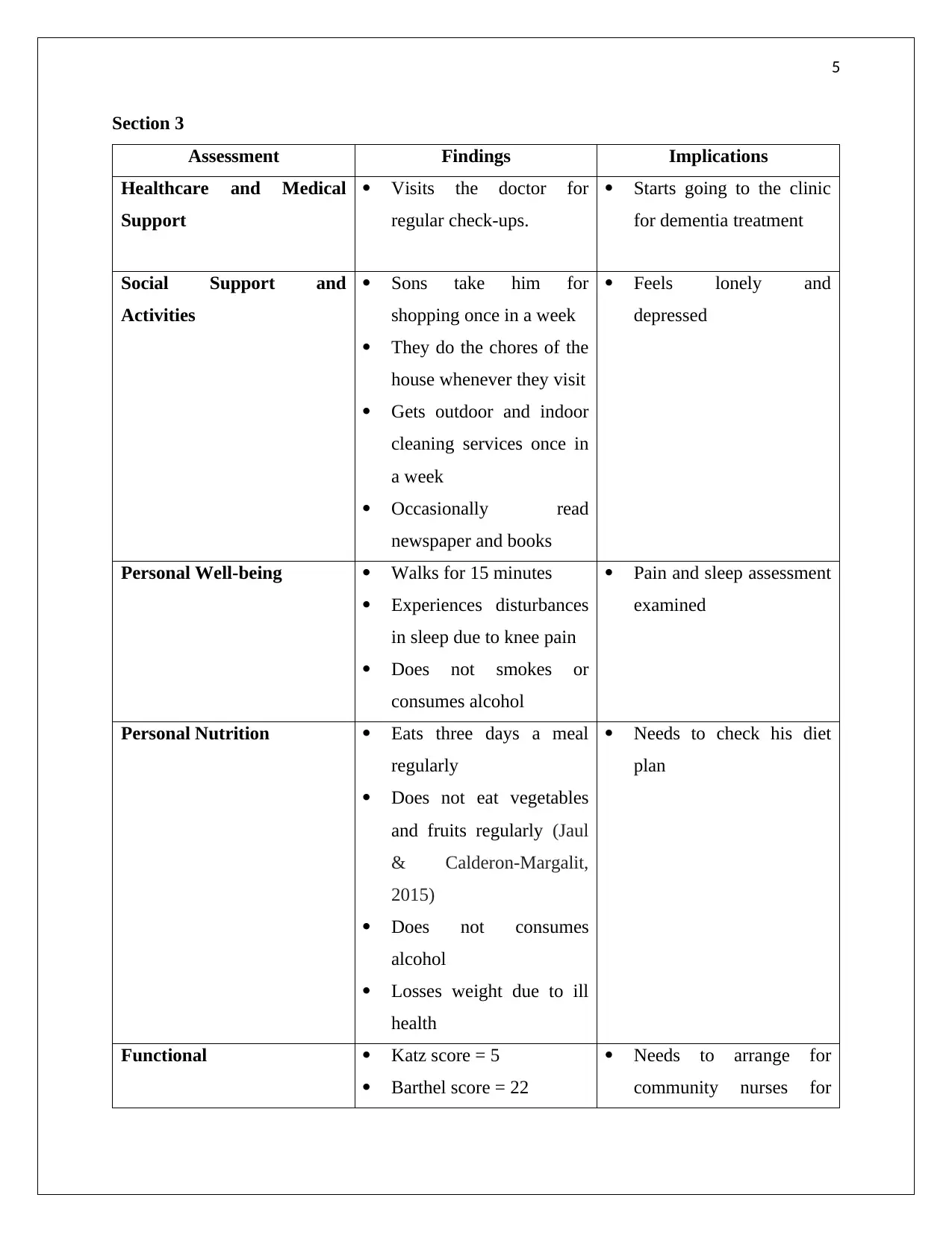
5
Section 3
Assessment Findings Implications
Healthcare and Medical
Support
Visits the doctor for
regular check-ups.
Starts going to the clinic
for dementia treatment
Social Support and
Activities
Sons take him for
shopping once in a week
They do the chores of the
house whenever they visit
Gets outdoor and indoor
cleaning services once in
a week
Occasionally read
newspaper and books
Feels lonely and
depressed
Personal Well-being Walks for 15 minutes
Experiences disturbances
in sleep due to knee pain
Does not smokes or
consumes alcohol
Pain and sleep assessment
examined
Personal Nutrition Eats three days a meal
regularly
Does not eat vegetables
and fruits regularly (Jaul
& Calderon‐Margalit,
2015)
Does not consumes
alcohol
Losses weight due to ill
health
Needs to check his diet
plan
Functional Katz score = 5
Barthel score = 22
Needs to arrange for
community nurses for
Section 3
Assessment Findings Implications
Healthcare and Medical
Support
Visits the doctor for
regular check-ups.
Starts going to the clinic
for dementia treatment
Social Support and
Activities
Sons take him for
shopping once in a week
They do the chores of the
house whenever they visit
Gets outdoor and indoor
cleaning services once in
a week
Occasionally read
newspaper and books
Feels lonely and
depressed
Personal Well-being Walks for 15 minutes
Experiences disturbances
in sleep due to knee pain
Does not smokes or
consumes alcohol
Pain and sleep assessment
examined
Personal Nutrition Eats three days a meal
regularly
Does not eat vegetables
and fruits regularly (Jaul
& Calderon‐Margalit,
2015)
Does not consumes
alcohol
Losses weight due to ill
health
Needs to check his diet
plan
Functional Katz score = 5
Barthel score = 22
Needs to arrange for
community nurses for
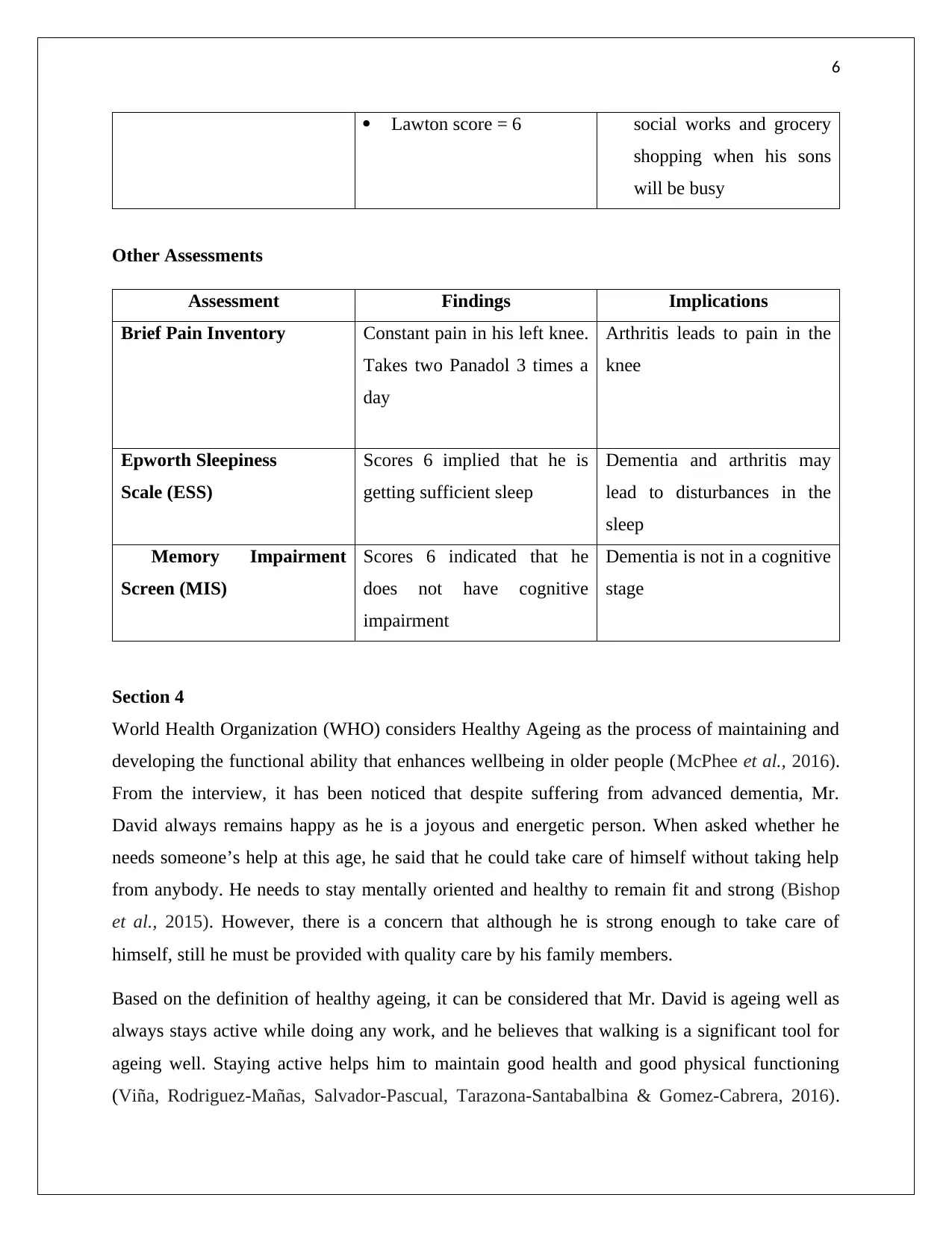
6
Lawton score = 6 social works and grocery
shopping when his sons
will be busy
Other Assessments
Assessment Findings Implications
Brief Pain Inventory Constant pain in his left knee.
Takes two Panadol 3 times a
day
Arthritis leads to pain in the
knee
Epworth Sleepiness
Scale (ESS)
Scores 6 implied that he is
getting sufficient sleep
Dementia and arthritis may
lead to disturbances in the
sleep
Memory Impairment
Screen (MIS)
Scores 6 indicated that he
does not have cognitive
impairment
Dementia is not in a cognitive
stage
Section 4
World Health Organization (WHO) considers Healthy Ageing as the process of maintaining and
developing the functional ability that enhances wellbeing in older people (McPhee et al., 2016).
From the interview, it has been noticed that despite suffering from advanced dementia, Mr.
David always remains happy as he is a joyous and energetic person. When asked whether he
needs someone’s help at this age, he said that he could take care of himself without taking help
from anybody. He needs to stay mentally oriented and healthy to remain fit and strong (Bishop
et al., 2015). However, there is a concern that although he is strong enough to take care of
himself, still he must be provided with quality care by his family members.
Based on the definition of healthy ageing, it can be considered that Mr. David is ageing well as
always stays active while doing any work, and he believes that walking is a significant tool for
ageing well. Staying active helps him to maintain good health and good physical functioning
(Viña, Rodriguez‐Mañas, Salvador‐Pascual, Tarazona‐Santabalbina & Gomez‐Cabrera, 2016).
Lawton score = 6 social works and grocery
shopping when his sons
will be busy
Other Assessments
Assessment Findings Implications
Brief Pain Inventory Constant pain in his left knee.
Takes two Panadol 3 times a
day
Arthritis leads to pain in the
knee
Epworth Sleepiness
Scale (ESS)
Scores 6 implied that he is
getting sufficient sleep
Dementia and arthritis may
lead to disturbances in the
sleep
Memory Impairment
Screen (MIS)
Scores 6 indicated that he
does not have cognitive
impairment
Dementia is not in a cognitive
stage
Section 4
World Health Organization (WHO) considers Healthy Ageing as the process of maintaining and
developing the functional ability that enhances wellbeing in older people (McPhee et al., 2016).
From the interview, it has been noticed that despite suffering from advanced dementia, Mr.
David always remains happy as he is a joyous and energetic person. When asked whether he
needs someone’s help at this age, he said that he could take care of himself without taking help
from anybody. He needs to stay mentally oriented and healthy to remain fit and strong (Bishop
et al., 2015). However, there is a concern that although he is strong enough to take care of
himself, still he must be provided with quality care by his family members.
Based on the definition of healthy ageing, it can be considered that Mr. David is ageing well as
always stays active while doing any work, and he believes that walking is a significant tool for
ageing well. Staying active helps him to maintain good health and good physical functioning
(Viña, Rodriguez‐Mañas, Salvador‐Pascual, Tarazona‐Santabalbina & Gomez‐Cabrera, 2016).
Paraphrase This Document
Need a fresh take? Get an instant paraphrase of this document with our AI Paraphraser
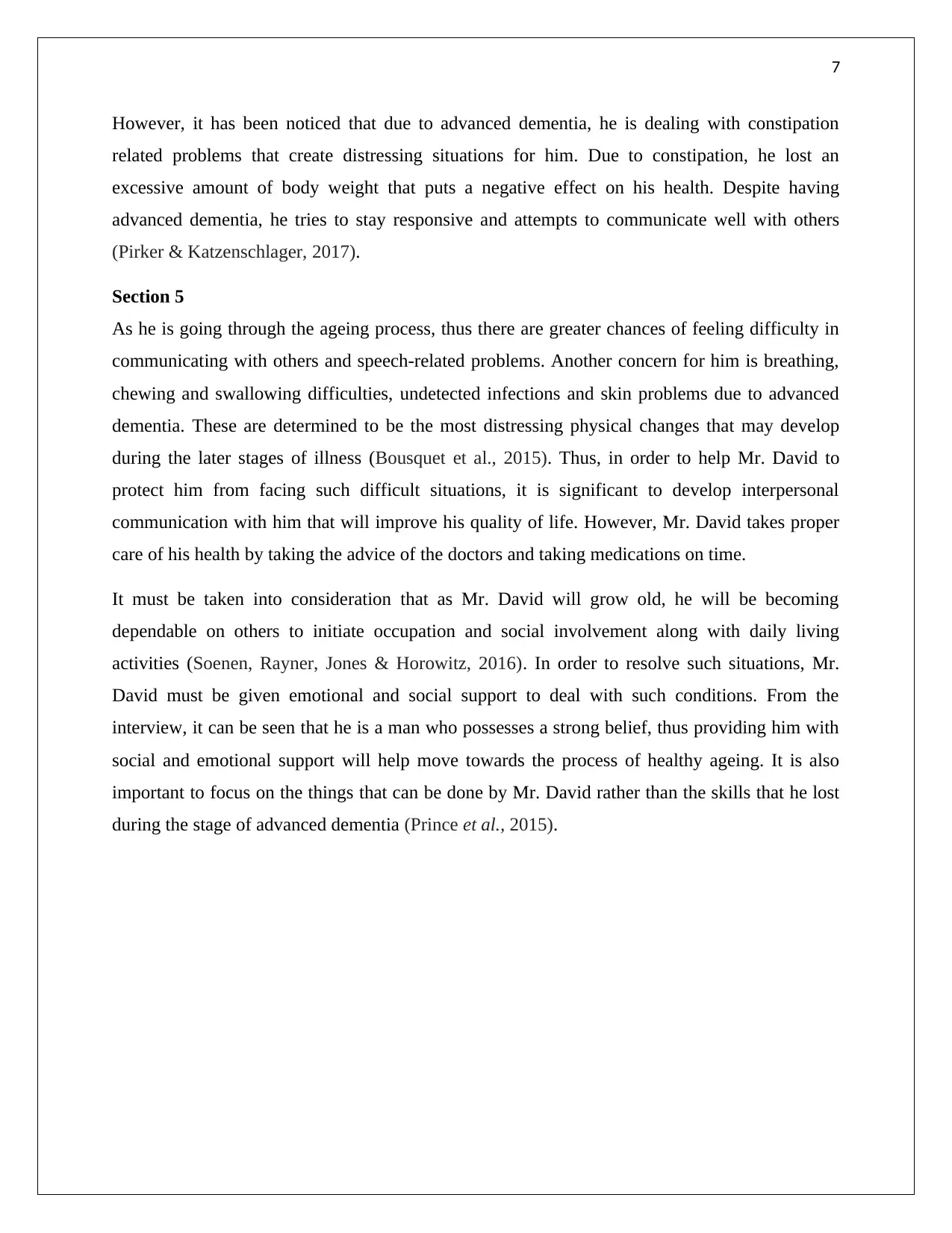
7
However, it has been noticed that due to advanced dementia, he is dealing with constipation
related problems that create distressing situations for him. Due to constipation, he lost an
excessive amount of body weight that puts a negative effect on his health. Despite having
advanced dementia, he tries to stay responsive and attempts to communicate well with others
(Pirker & Katzenschlager, 2017).
Section 5
As he is going through the ageing process, thus there are greater chances of feeling difficulty in
communicating with others and speech-related problems. Another concern for him is breathing,
chewing and swallowing difficulties, undetected infections and skin problems due to advanced
dementia. These are determined to be the most distressing physical changes that may develop
during the later stages of illness (Bousquet et al., 2015). Thus, in order to help Mr. David to
protect him from facing such difficult situations, it is significant to develop interpersonal
communication with him that will improve his quality of life. However, Mr. David takes proper
care of his health by taking the advice of the doctors and taking medications on time.
It must be taken into consideration that as Mr. David will grow old, he will be becoming
dependable on others to initiate occupation and social involvement along with daily living
activities (Soenen, Rayner, Jones & Horowitz, 2016). In order to resolve such situations, Mr.
David must be given emotional and social support to deal with such conditions. From the
interview, it can be seen that he is a man who possesses a strong belief, thus providing him with
social and emotional support will help move towards the process of healthy ageing. It is also
important to focus on the things that can be done by Mr. David rather than the skills that he lost
during the stage of advanced dementia (Prince et al., 2015).
However, it has been noticed that due to advanced dementia, he is dealing with constipation
related problems that create distressing situations for him. Due to constipation, he lost an
excessive amount of body weight that puts a negative effect on his health. Despite having
advanced dementia, he tries to stay responsive and attempts to communicate well with others
(Pirker & Katzenschlager, 2017).
Section 5
As he is going through the ageing process, thus there are greater chances of feeling difficulty in
communicating with others and speech-related problems. Another concern for him is breathing,
chewing and swallowing difficulties, undetected infections and skin problems due to advanced
dementia. These are determined to be the most distressing physical changes that may develop
during the later stages of illness (Bousquet et al., 2015). Thus, in order to help Mr. David to
protect him from facing such difficult situations, it is significant to develop interpersonal
communication with him that will improve his quality of life. However, Mr. David takes proper
care of his health by taking the advice of the doctors and taking medications on time.
It must be taken into consideration that as Mr. David will grow old, he will be becoming
dependable on others to initiate occupation and social involvement along with daily living
activities (Soenen, Rayner, Jones & Horowitz, 2016). In order to resolve such situations, Mr.
David must be given emotional and social support to deal with such conditions. From the
interview, it can be seen that he is a man who possesses a strong belief, thus providing him with
social and emotional support will help move towards the process of healthy ageing. It is also
important to focus on the things that can be done by Mr. David rather than the skills that he lost
during the stage of advanced dementia (Prince et al., 2015).
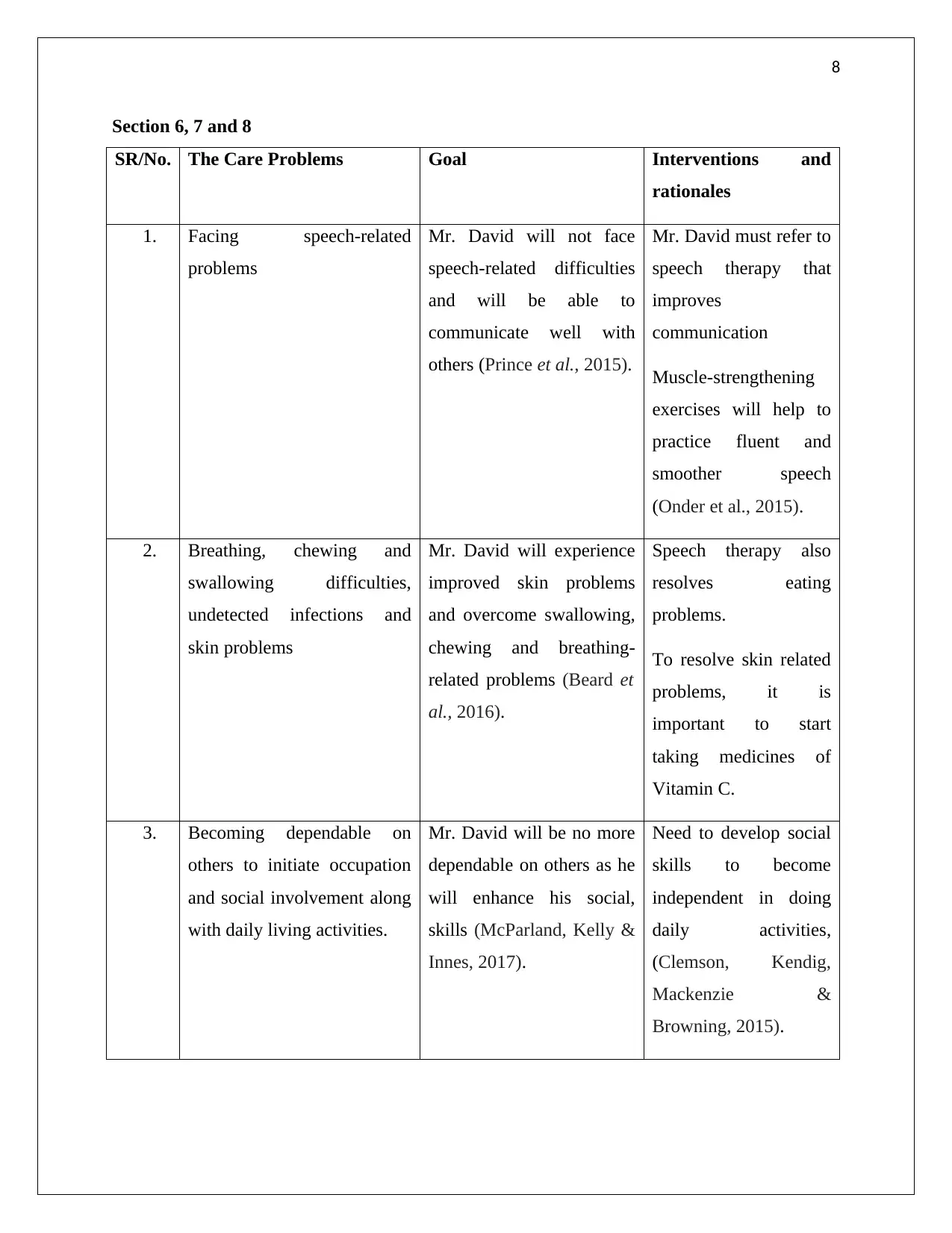
8
Section 6, 7 and 8
SR/No. The Care Problems Goal Interventions and
rationales
1. Facing speech-related
problems
Mr. David will not face
speech-related difficulties
and will be able to
communicate well with
others (Prince et al., 2015).
Mr. David must refer to
speech therapy that
improves
communication
Muscle-strengthening
exercises will help to
practice fluent and
smoother speech
(Onder et al., 2015).
2. Breathing, chewing and
swallowing difficulties,
undetected infections and
skin problems
Mr. David will experience
improved skin problems
and overcome swallowing,
chewing and breathing-
related problems (Beard et
al., 2016).
Speech therapy also
resolves eating
problems.
To resolve skin related
problems, it is
important to start
taking medicines of
Vitamin C.
3. Becoming dependable on
others to initiate occupation
and social involvement along
with daily living activities.
Mr. David will be no more
dependable on others as he
will enhance his social,
skills (McParland, Kelly &
Innes, 2017).
Need to develop social
skills to become
independent in doing
daily activities,
(Clemson, Kendig,
Mackenzie &
Browning, 2015).
Section 6, 7 and 8
SR/No. The Care Problems Goal Interventions and
rationales
1. Facing speech-related
problems
Mr. David will not face
speech-related difficulties
and will be able to
communicate well with
others (Prince et al., 2015).
Mr. David must refer to
speech therapy that
improves
communication
Muscle-strengthening
exercises will help to
practice fluent and
smoother speech
(Onder et al., 2015).
2. Breathing, chewing and
swallowing difficulties,
undetected infections and
skin problems
Mr. David will experience
improved skin problems
and overcome swallowing,
chewing and breathing-
related problems (Beard et
al., 2016).
Speech therapy also
resolves eating
problems.
To resolve skin related
problems, it is
important to start
taking medicines of
Vitamin C.
3. Becoming dependable on
others to initiate occupation
and social involvement along
with daily living activities.
Mr. David will be no more
dependable on others as he
will enhance his social,
skills (McParland, Kelly &
Innes, 2017).
Need to develop social
skills to become
independent in doing
daily activities,
(Clemson, Kendig,
Mackenzie &
Browning, 2015).
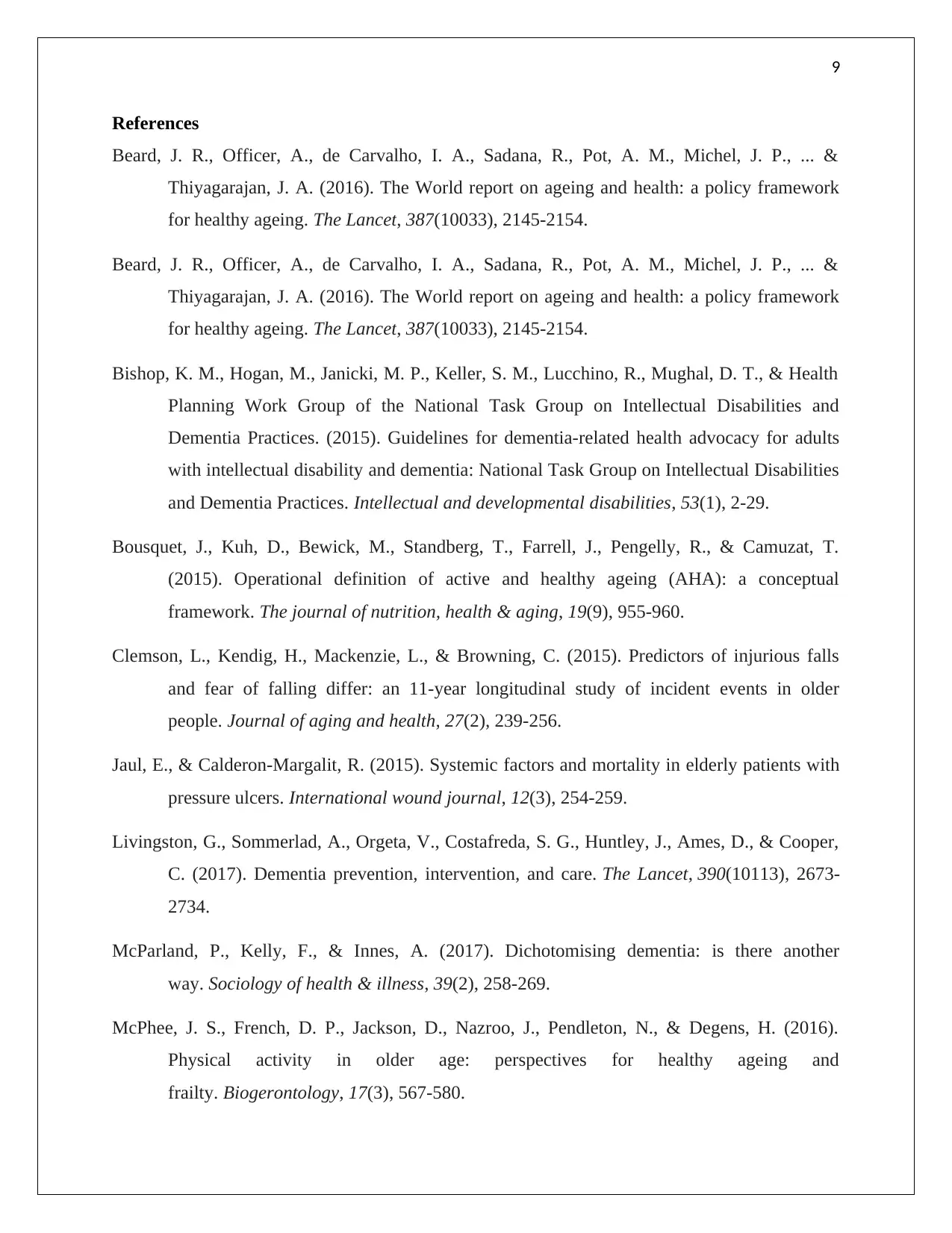
9
References
Beard, J. R., Officer, A., de Carvalho, I. A., Sadana, R., Pot, A. M., Michel, J. P., ... &
Thiyagarajan, J. A. (2016). The World report on ageing and health: a policy framework
for healthy ageing. The Lancet, 387(10033), 2145-2154.
Beard, J. R., Officer, A., de Carvalho, I. A., Sadana, R., Pot, A. M., Michel, J. P., ... &
Thiyagarajan, J. A. (2016). The World report on ageing and health: a policy framework
for healthy ageing. The Lancet, 387(10033), 2145-2154.
Bishop, K. M., Hogan, M., Janicki, M. P., Keller, S. M., Lucchino, R., Mughal, D. T., & Health
Planning Work Group of the National Task Group on Intellectual Disabilities and
Dementia Practices. (2015). Guidelines for dementia-related health advocacy for adults
with intellectual disability and dementia: National Task Group on Intellectual Disabilities
and Dementia Practices. Intellectual and developmental disabilities, 53(1), 2-29.
Bousquet, J., Kuh, D., Bewick, M., Standberg, T., Farrell, J., Pengelly, R., & Camuzat, T.
(2015). Operational definition of active and healthy ageing (AHA): a conceptual
framework. The journal of nutrition, health & aging, 19(9), 955-960.
Clemson, L., Kendig, H., Mackenzie, L., & Browning, C. (2015). Predictors of injurious falls
and fear of falling differ: an 11-year longitudinal study of incident events in older
people. Journal of aging and health, 27(2), 239-256.
Jaul, E., & Calderon‐Margalit, R. (2015). Systemic factors and mortality in elderly patients with
pressure ulcers. International wound journal, 12(3), 254-259.
Livingston, G., Sommerlad, A., Orgeta, V., Costafreda, S. G., Huntley, J., Ames, D., & Cooper,
C. (2017). Dementia prevention, intervention, and care. The Lancet, 390(10113), 2673-
2734.
McParland, P., Kelly, F., & Innes, A. (2017). Dichotomising dementia: is there another
way. Sociology of health & illness, 39(2), 258-269.
McPhee, J. S., French, D. P., Jackson, D., Nazroo, J., Pendleton, N., & Degens, H. (2016).
Physical activity in older age: perspectives for healthy ageing and
frailty. Biogerontology, 17(3), 567-580.
References
Beard, J. R., Officer, A., de Carvalho, I. A., Sadana, R., Pot, A. M., Michel, J. P., ... &
Thiyagarajan, J. A. (2016). The World report on ageing and health: a policy framework
for healthy ageing. The Lancet, 387(10033), 2145-2154.
Beard, J. R., Officer, A., de Carvalho, I. A., Sadana, R., Pot, A. M., Michel, J. P., ... &
Thiyagarajan, J. A. (2016). The World report on ageing and health: a policy framework
for healthy ageing. The Lancet, 387(10033), 2145-2154.
Bishop, K. M., Hogan, M., Janicki, M. P., Keller, S. M., Lucchino, R., Mughal, D. T., & Health
Planning Work Group of the National Task Group on Intellectual Disabilities and
Dementia Practices. (2015). Guidelines for dementia-related health advocacy for adults
with intellectual disability and dementia: National Task Group on Intellectual Disabilities
and Dementia Practices. Intellectual and developmental disabilities, 53(1), 2-29.
Bousquet, J., Kuh, D., Bewick, M., Standberg, T., Farrell, J., Pengelly, R., & Camuzat, T.
(2015). Operational definition of active and healthy ageing (AHA): a conceptual
framework. The journal of nutrition, health & aging, 19(9), 955-960.
Clemson, L., Kendig, H., Mackenzie, L., & Browning, C. (2015). Predictors of injurious falls
and fear of falling differ: an 11-year longitudinal study of incident events in older
people. Journal of aging and health, 27(2), 239-256.
Jaul, E., & Calderon‐Margalit, R. (2015). Systemic factors and mortality in elderly patients with
pressure ulcers. International wound journal, 12(3), 254-259.
Livingston, G., Sommerlad, A., Orgeta, V., Costafreda, S. G., Huntley, J., Ames, D., & Cooper,
C. (2017). Dementia prevention, intervention, and care. The Lancet, 390(10113), 2673-
2734.
McParland, P., Kelly, F., & Innes, A. (2017). Dichotomising dementia: is there another
way. Sociology of health & illness, 39(2), 258-269.
McPhee, J. S., French, D. P., Jackson, D., Nazroo, J., Pendleton, N., & Degens, H. (2016).
Physical activity in older age: perspectives for healthy ageing and
frailty. Biogerontology, 17(3), 567-580.
Secure Best Marks with AI Grader
Need help grading? Try our AI Grader for instant feedback on your assignments.
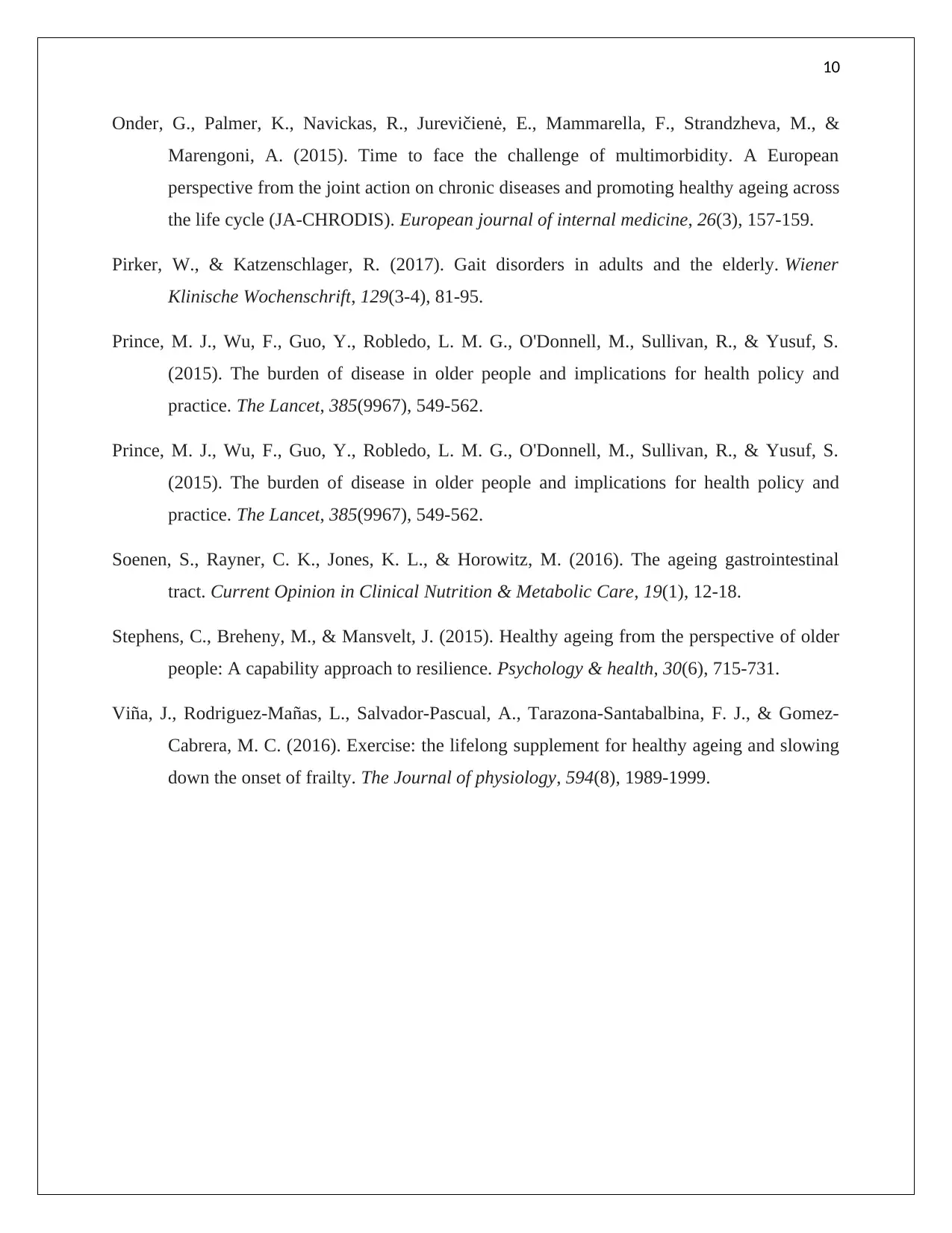
10
Onder, G., Palmer, K., Navickas, R., Jurevičienė, E., Mammarella, F., Strandzheva, M., &
Marengoni, A. (2015). Time to face the challenge of multimorbidity. A European
perspective from the joint action on chronic diseases and promoting healthy ageing across
the life cycle (JA-CHRODIS). European journal of internal medicine, 26(3), 157-159.
Pirker, W., & Katzenschlager, R. (2017). Gait disorders in adults and the elderly. Wiener
Klinische Wochenschrift, 129(3-4), 81-95.
Prince, M. J., Wu, F., Guo, Y., Robledo, L. M. G., O'Donnell, M., Sullivan, R., & Yusuf, S.
(2015). The burden of disease in older people and implications for health policy and
practice. The Lancet, 385(9967), 549-562.
Prince, M. J., Wu, F., Guo, Y., Robledo, L. M. G., O'Donnell, M., Sullivan, R., & Yusuf, S.
(2015). The burden of disease in older people and implications for health policy and
practice. The Lancet, 385(9967), 549-562.
Soenen, S., Rayner, C. K., Jones, K. L., & Horowitz, M. (2016). The ageing gastrointestinal
tract. Current Opinion in Clinical Nutrition & Metabolic Care, 19(1), 12-18.
Stephens, C., Breheny, M., & Mansvelt, J. (2015). Healthy ageing from the perspective of older
people: A capability approach to resilience. Psychology & health, 30(6), 715-731.
Viña, J., Rodriguez‐Mañas, L., Salvador‐Pascual, A., Tarazona‐Santabalbina, F. J., & Gomez‐
Cabrera, M. C. (2016). Exercise: the lifelong supplement for healthy ageing and slowing
down the onset of frailty. The Journal of physiology, 594(8), 1989-1999.
Onder, G., Palmer, K., Navickas, R., Jurevičienė, E., Mammarella, F., Strandzheva, M., &
Marengoni, A. (2015). Time to face the challenge of multimorbidity. A European
perspective from the joint action on chronic diseases and promoting healthy ageing across
the life cycle (JA-CHRODIS). European journal of internal medicine, 26(3), 157-159.
Pirker, W., & Katzenschlager, R. (2017). Gait disorders in adults and the elderly. Wiener
Klinische Wochenschrift, 129(3-4), 81-95.
Prince, M. J., Wu, F., Guo, Y., Robledo, L. M. G., O'Donnell, M., Sullivan, R., & Yusuf, S.
(2015). The burden of disease in older people and implications for health policy and
practice. The Lancet, 385(9967), 549-562.
Prince, M. J., Wu, F., Guo, Y., Robledo, L. M. G., O'Donnell, M., Sullivan, R., & Yusuf, S.
(2015). The burden of disease in older people and implications for health policy and
practice. The Lancet, 385(9967), 549-562.
Soenen, S., Rayner, C. K., Jones, K. L., & Horowitz, M. (2016). The ageing gastrointestinal
tract. Current Opinion in Clinical Nutrition & Metabolic Care, 19(1), 12-18.
Stephens, C., Breheny, M., & Mansvelt, J. (2015). Healthy ageing from the perspective of older
people: A capability approach to resilience. Psychology & health, 30(6), 715-731.
Viña, J., Rodriguez‐Mañas, L., Salvador‐Pascual, A., Tarazona‐Santabalbina, F. J., & Gomez‐
Cabrera, M. C. (2016). Exercise: the lifelong supplement for healthy ageing and slowing
down the onset of frailty. The Journal of physiology, 594(8), 1989-1999.
1 out of 11
Your All-in-One AI-Powered Toolkit for Academic Success.
+13062052269
info@desklib.com
Available 24*7 on WhatsApp / Email
![[object Object]](/_next/static/media/star-bottom.7253800d.svg)
Unlock your academic potential
© 2024 | Zucol Services PVT LTD | All rights reserved.